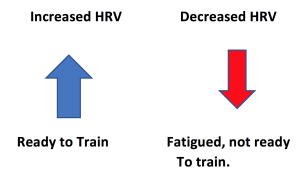In our last article, we looked a simple field test (orthostatic heart rate test) to identify your clients’ readiness to train and the likelihood of fatigue. In this week’s article, we will look at a new emerging technology which might be available to you right now on your phone! I predict that the heart rate variability technologies will eventually find their way into the fitness industry and be used by trainers and clients on a regular basis. Heart rate variability is essentially the variation between each beat of your heart. Your heart rate and the variability between beats is regulated by your sympathetic and parasympathetic branches of the autonomic nervous system. Thus, heart rate variability can be used to determine the balance of these two opposing systems (fight or flight), our state of recovery, bodily functions at rest and ultimately how we react to stressors (training, diet, sleep, life stressors etc). Having a knowledge of this, can help you and your client understand important trends, such as the effect of sleep on the readiness to train intensely on a regular basis, recovery from previous training sessions and chronic stress patterns. It is important to have a basic understanding on the basic principles of heart rate variability.
Greater heart rate variability indicates the body is less fatigued and a lower heart rate variability indicates the body is more fatigued, as outlined below:

Heart rate variability provides a quick snapshot of your clients’ state of fatigue, with newer technologies, heart rate variability can be measured conveniently with relatively inexpensive equipment. For example, new models of the Samsung phones have an infrared sensor that captures heart rate variability. For less than $100.00 you can buy a finger probe (ithlete), that connects to most Android and Apple phones and provides an accurate heart rate variability measurement, and with the adjoining app, an easy to read chart providing you with a clear interpretation of the measurement, allowing you to optimize your clients’ performance by putting the brakes on training intensity when scores are lower and when to hit the accelerator and train harder when scores are higher as indicated below:

If you decide to invest in a heart rate variability device, there are a few important points you need remember to ensure the measurements are accurate. They include:
- Take the reading upon waking, in a relaxed state.
- Limit all external stressors (don’t read email, social media etc beforehand)
- Make sure you are sitting or lying still, minimise all movements
- Pace your breathing, as breathing patterns can impact heart variability measurements, typically you should pace your breathing to 8-12 breaths per minute.
- Measurements should be taken in 1 minute.
There we have it, along with the orthostatic heart rate test, heart rate variability can be a valuable tool, enabling the client and trainer to gain a greater insight both training and lifestyle choices that affect fatigue. I strongly encourage you to consider heart rate variability, as I alluded to earlier, it is only a matter of time, before your clients may start to ask you more about it.
For for Newsletter

